One of the most common problems with basil is overwatering but if you know what to do, you can almost always save your plants.
I have overwatered many of my basil plants in the past. Sure, that isn’t ideal but it has also given me a chance to figure out how to save them, so I have tested several different tricks and some of them worked extremely well.
The last time I overwatered basil, I also spoke to a professional gardener with more than a decade of experience to ask if she had some tips and tricks that I did not already know about and she did.
In this post, you will learn the 9 best tips and tricks I have tested for saving overwatered basil that actually work.
If your basil is struggling but you are not sure that it is because of overwatering, I strongly encourage you to take a look at this post to figure out if that is actually the problem before you start doing what I show in this article.
1. Prune Your Basil by Removing the Yellow Leaves

The first sign that basil has been getting too much water is that some of the leaves will begin to turn yellow or brown starting from the bottom and then slowly moving upwards towards the top of the plant.
As soon as you notice basil leaves turning yellow or brown, the first thing you should do is to carefully prune the plant by removing any yellow or brown leaves. Use clean pruning shears to avoid damaging the plant.
I have a guide on how to prune basil correctly on this link.
My plant in the photo above is quite small but is actually already showing some signs of overwatering so I just removed the bottom leaves since the rest of the leaves looked fine.
Your basil might be significantly larger than mine so the pruning needed may also be significantly more than just removing the bottom leaves.
Removing yellow or brown leaves from your basil allows the plant to focus its energy on growing and producing more healthy leaves.
Pruning basil also leads to larger, more bushy plants that produces much more than if you don’t prune them.
2. Let the Topsoil Dry Out
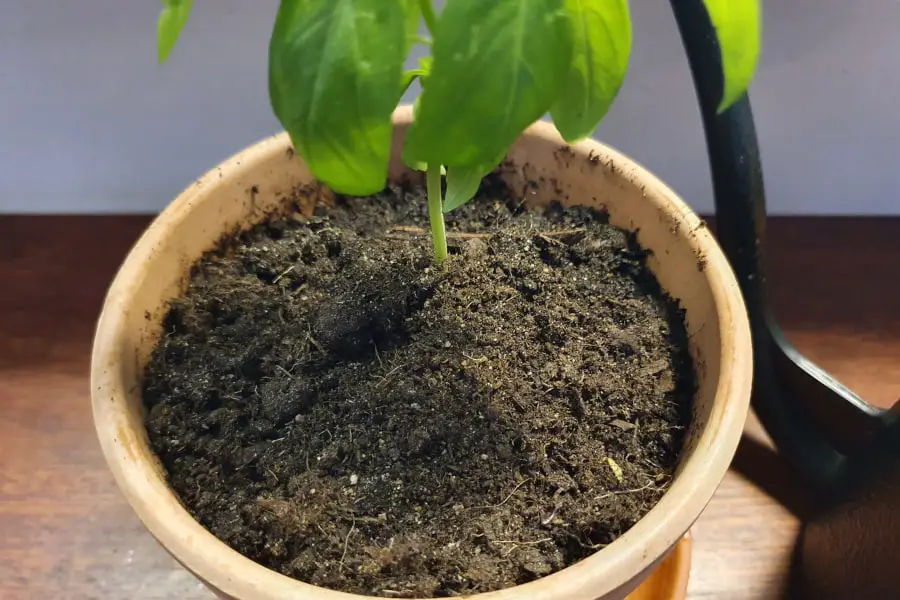
Once you have removed any yellow or brown leaves from your basil, it is time to let the soil dry out a bit.
Basil likes moist soil and the soil should never dry out completely but if the roots are completely soaked, they will end up rotting which will kill the plant.
It is important to let the top of the soil dry out before you water your basil. Do not let all the soil dry out completely, however, since basil likes some moisture at all times. If you are unsure, lightly touch the top of the soil with a fingertip and if the soil feels dry, give it some water but if not, wait.
Be careful that you do not push the soil too hard when you touch it since it can put unnecessary pressure on the roots.
If your plant is growing in a plastic pot or something similar where it is easy to carefully lift it out, you can try to do that to see how wet the soil is and how the roots are doing.
I don’t recommend trying to remove your basil from its pot since it is easy to accidentally damage the plant. If you do it anyway, just be very careful not to damage the plant or the roots.
The roots should be white and look fresh. If they are brown and soggy, you are probably looking at root rot and if that becomes too widespread in the root system, the plant is unlikely to survive.
If your roots are completely brown and soggy, skip to tip number 9 but if that is not the case, try these next tips.
3. Remove the Plate from Under the Basil

Basil prefers to grow in well-drained soil where the water can seep through easily so I always recommend using a pot with good drainage and a plate underneath.
I almost always use some very standard terracotta pots like the one in the photo above. They work excellently for most plants since they have great drainage.
This tip is of course only relevant if you grow your basil in a pot that has a plate underneath it but if you are not doing that, I highly recommend it since it can improve the air and water flow in your soil.
Remove the plate from underneath the pot where your basil is growing to allow the water to seep through more easily. Put the pot on the ground, on your bathroom floor, in a sink, or similar, and let it stay there overnight.
4. Remove Mulch from Around the Plant

Mulch can be an excellent thing to use in your garden since it can keep the soil moist much more efficiently than if you do not use mulch.
Since the issue we are dealing with here is overwatering, however, you should remove any mulch from the soil around the basil so the water can evaporate faster until the plant is back on track.
To allow the top of the soil to dry out more easily, remove any mulch, stones, or similar from around your basil. The increased amount of air and sunlight that reaches the soil will allow the water to evaporate faster than if it was covered.
5. Always Water Your Basil with Lime-free Water
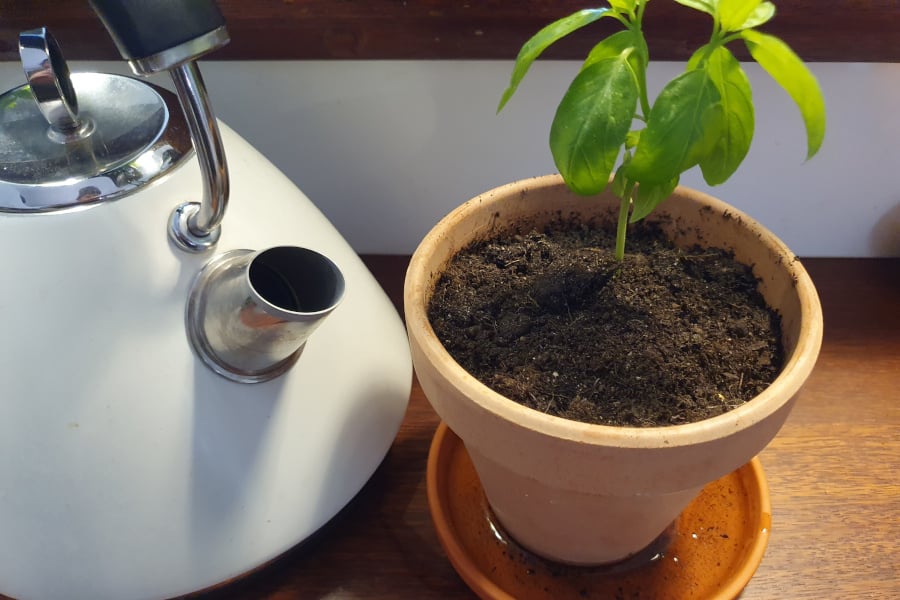
A common mistake when watering basil (and other plants for that matter) is to use regular tap water.
Tap water can be just fine but sometimes it contains a high amount of lime which can cause problems.
Water with too much lime can inhibit plants’ ability to obtain nutrients from the soil.
The ideal water to use for watering basil is rainwater since it is completely lime-free but if that is not an option, using a kettle to boil water and then letting it cool down to room temperature before using it can be an excellent way of getting lime-free water for your plants.
6. Water Your Basil from the Bottom
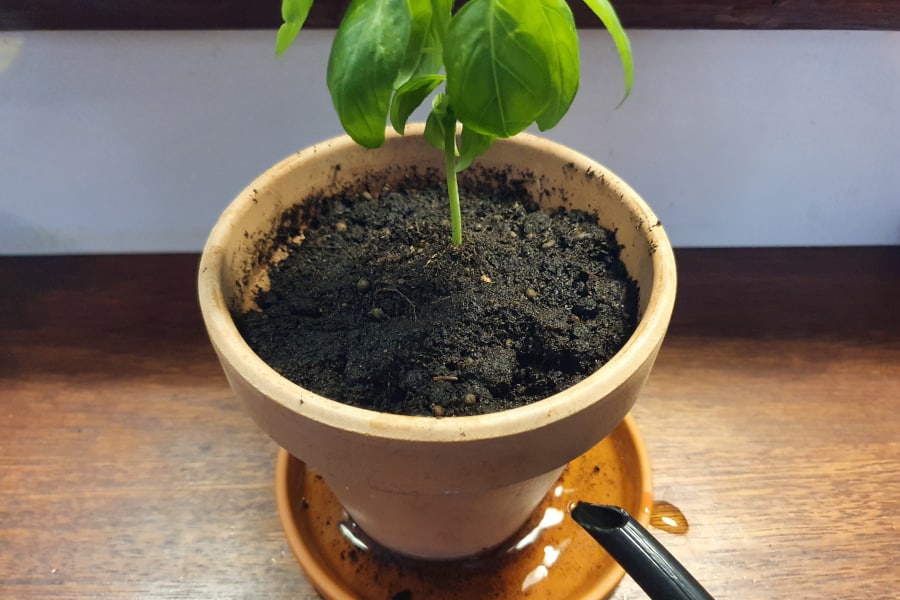
This is actually a good general tip for all garden plants but especially for basil since it is not a very large plant and can be more fragile than some other plants.
When basil is soaked for too long, it can begin to rot and once the main stem of the plant begins to rot, it can be difficult to save the plant.
The best way to water basil is to add the water to the plate under the pot. The soil will absorb the water and the roots will begin to obtain it directly without the plant itself getting soaked. Watering from the bottom also forces the roots to grow and seek out the water which leads to a larger, healthier plant.
I actually highly recommend watering your plants this way since it can reduce the risk of your plants rotting and also force the roots to grow larger to reach the water. You can read more about it in my article on this link.
A larger, stronger root system is the best way to make garden plants healthy and grow large since a larger root system increases the plant’s ability to obtain water and nutrients from the soil.
7. Give Your Basil 6-8 Hours of Full Sun Per Day
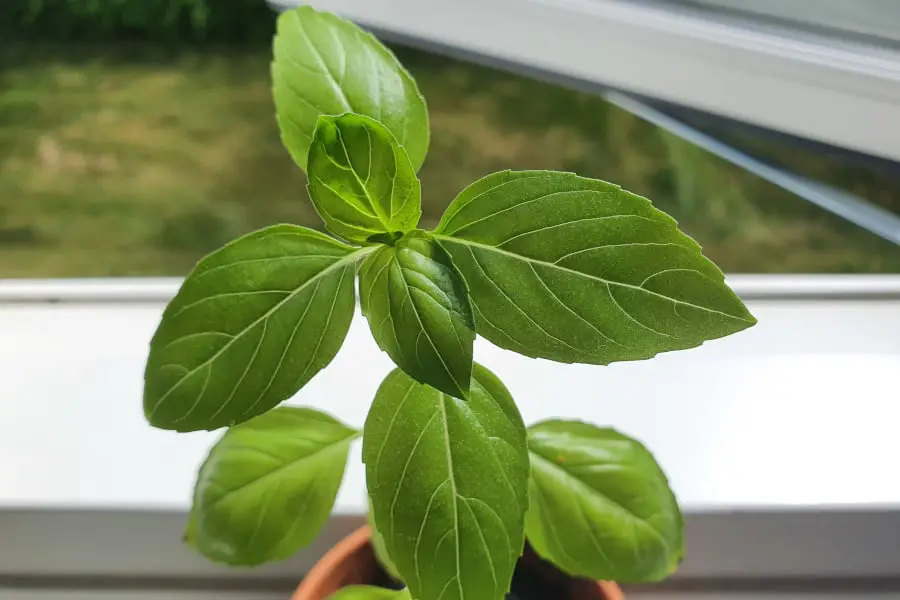
Basil generally likes a lot of sunlight and thrives in the summer but it can definitely also get too much sun which can harm or even kill the plant.
Ironically enough, too much direct sunlight can significantly increase the risk of overwatering basil since it will cause the plant to start wilting. This essentially means that the leaves will fold and hang loose on the plant.
When plants are wilting, the overall surface area of the leaves is reduced which inhibits the plants’ ability to absorb sunlight. When plants are not able to absorb as much sunlight, they are also not able to get rid of water as efficiently so while your basil should of course get enough sunlight, it is also important not to give it too much.
As a general rule, basil should get between 6-8 hours of direct sunlight per day. This provides it with the energy needed to grow and produce efficiently without getting burnt. If basil gets too much sun, it will begin to wilt which reduces the plant’s ability to get rid of water and increases the risk of overwatering.
It is impossible to say exactly how much direct sunlight your specific basil should have since it depends on the size of the plant, where it is growing, how high the temperature is, and more but keep an eye on the plant and if it begins to wilt, it might be getting too much sunlight.
If you grow basil in a pot or container, it is easy to move it around and it can benefit greatly from being moved out of direct sunlight in the afternoon if it has already gotten between 6-8 hours of direct sunlight.
If you are growing basil indoors by a window, it can take quite a bit more heat and sunlight than in a greenhouse. First of all, since the temperatures in a greenhouse can get extremely high but also since the glass in a greenhouse rarely has any UV filtering which windows in a house or apartment usually does.
8. Grow Your Basil in a Large Pot
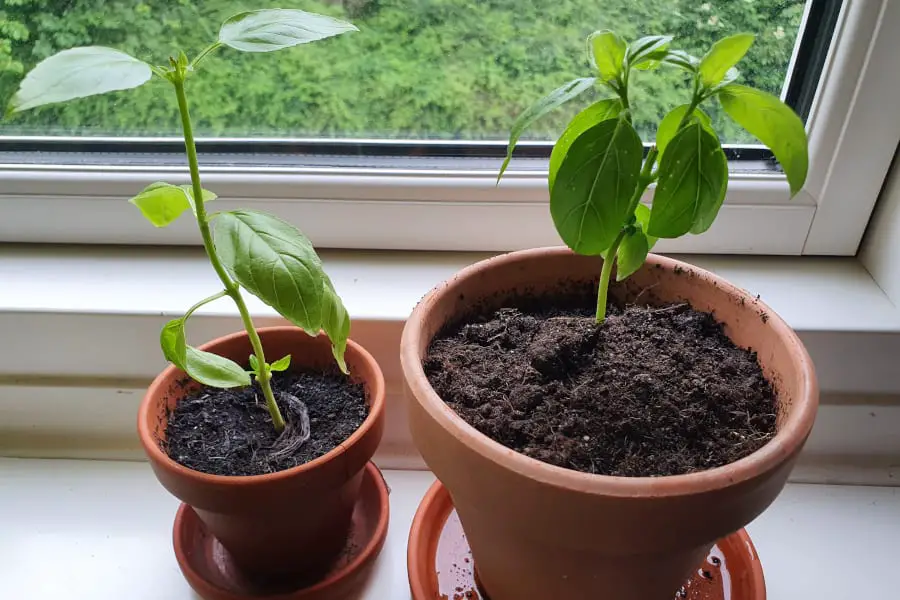
I recommend using a pot that is a bit larger than you might expect when growing basil and the photo above shows exactly why.
The picture is of 2 basil plants I am currently growing and as you can see, the one on the right which is growing in a larger pot is doing significantly better than the one in the small pot on the left.
A larger pot means more soil and therefore more room for roots to grow and the larger the root system is, the stronger the basil will be and the faster it will grow and produce.
In my experience, a larger pot with more soil also makes it much more difficult to overwater basil than if you are growing it in a small pot. The primary reason for this is that it simply takes a lot more water before it is too much. In addition to that, more space usually means a bigger root system which can help the plant absorb the water more efficiently.
I have a detailed explanation of how to find the perfect pot for your basil here.
If you are already using a small pot for your basil, you can try to transplant it to a larger pot but if you do this, you have to be very gentle and careful not to damage the plant or its roots.
9. Take Some Cuttings and Root Them in Water

If for whatever reason none of the tips above seem to work for you, taking cuttings and rooting them to grow them as new plants is an excellent way of saving basil that I have used multiple times myself.
To grow basil from cuttings, cut one of the stems from the plant and remove any leaves that are not at the very top of the plant. Place the cutting in a small glass or bowl of water for about a week and change the water daily. After about a week, new roots will sprout from the stem and it is ready to be planted in soil.
The photo above shows exactly what rooting basil cuttings should look like.
This is actually a great way of increasing the amount of basil you grow regardless if your plant is suffering from overwatering or not since it allows you to clone your plant without harming the mother plant.
I usually like to root a cutting or two in water like this when I prune my basil if I have room for the extra plants since it is an easy and free way to increase the amount of basil you have.
The best thing you can do to avoid overwatering your basil in the future is to know how to water it correctly. I have a guide for that here.
Read My Complete Guide to Growing and Caring for Basil
I have written a thorough guide where I cover all parts of growing your own basil including choosing a variety, sowing the seeds, the best growing conditions, pruning, propagation, harvesting, storing, solving various problems, and a lot more. You can find the article on this link.
